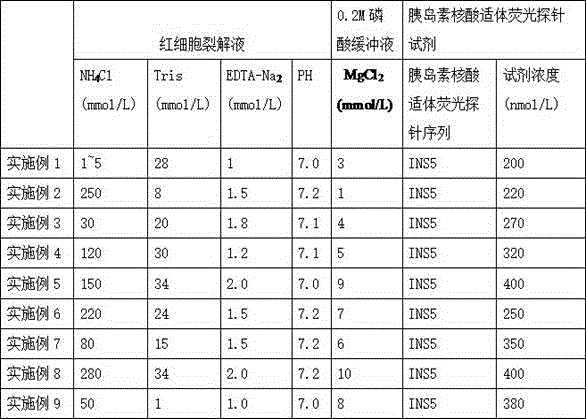INS5 insulin kit based on aptamer fluorescent probe and detection method of INS5 insulin
A nucleic acid aptamer and fluorescent probe technology, applied in the field of medical testing and determination, can solve the problems of operation technical errors, many interference factors, poor repeatability, etc., and achieve the effects of high repeatability, strong specificity and convenient transportation.
- Summary
- Abstract
- Description
- Claims
- Application Information
AI Technical Summary
Problems solved by technology
Method used
Image
Examples
Embodiment 1
[0032] After dissolving and preparing the required reagent components according to Example 1 in Table 1, divide into bottles and freeze-dry to make a dry powder reagent; before use, add ultrapure water and use after reconstitution. Three parallels were set for each sample, and the detection steps were as follows:
[0033] (1) Blood sample lysing: Mix heparin anticoagulated whole blood and erythrocyte lysate at a volume ratio of 1:0.5, let stand for 30 minutes, then centrifuge at a medium speed for 7 minutes, and collect the supernatant;
[0034] (2) Mixed egg incubation: take 20 μl of the supernatant obtained in step 1) and 45ul of the insulin aptamer fluorescent probe reagent obtained by dissolving the insulin aptamer fluorescent probe in 0.2M phosphate buffer, mix, and incubate eggs at room temperature for 5 minutes. get the test solution;
[0035] (3) Fluorescence detection: 50ul of the test solution obtained in the detection step 2) of the fluorescence detector, after the...
Embodiment 2
[0039] After dissolving and preparing the required reagent components according to Example 2 in Table 1, divide into bottles and freeze-dry to make a dry powder reagent; before use, add ultrapure water and use after reconstitution. Three parallels were set for each sample, and the detection steps were as follows:
[0040] (1) Blood sample lysis: Mix peripheral blood and red blood cell lysate at a volume ratio of 1:2.5, let stand for 5 minutes, then centrifuge at a medium speed for 6 minutes, and collect the supernatant;
[0041] (2) Mixed egg incubation: Take 50μl of the supernatant obtained in step 1) and 30ul of
[0042] The insulin aptamer fluorescent probe reagent obtained by dissolving the insulin aptamer fluorescent probe in 0.2M phosphate buffer solution was mixed, and the eggs were incubated at room temperature for 6 minutes to obtain the test solution;
[0043] (3) Fluorescence detection: 50ul of the test solution obtained in the detection step 2) of the fluorescence...
Embodiment 3
[0046] After dissolving and preparing the required reagent components according to Example 3 in Table 1, divide into bottles and freeze-dry to make a dry powder reagent; before use, add ultrapure water and use after reconstitution. Three parallels were set for each sample, and the detection steps were as follows:
[0047] (1) Blood sample lysis: Mix peripheral blood and red blood cell lysate at a volume ratio of 1:3.5, let stand for 10 minutes, then centrifuge at a medium speed for 5 minutes, and collect the supernatant;
[0048] (2) Mixed egg incubation: Take 75μl of the supernatant obtained in step 1) and 45ul of
[0049] The insulin aptamer fluorescent probe reagent obtained by dissolving the insulin aptamer fluorescent probe in 0.2M phosphate buffer solution was mixed, and the eggs were incubated at room temperature for 7 minutes to obtain the test solution;
[0050] (3) Fluorescence detection: 50ul of the test solution obtained in the detection step 2) of the fluorescenc...
PUM
 Login to View More
Login to View More Abstract
Description
Claims
Application Information
 Login to View More
Login to View More - R&D
- Intellectual Property
- Life Sciences
- Materials
- Tech Scout
- Unparalleled Data Quality
- Higher Quality Content
- 60% Fewer Hallucinations
Browse by: Latest US Patents, China's latest patents, Technical Efficacy Thesaurus, Application Domain, Technology Topic, Popular Technical Reports.
© 2025 PatSnap. All rights reserved.Legal|Privacy policy|Modern Slavery Act Transparency Statement|Sitemap|About US| Contact US: help@patsnap.com

